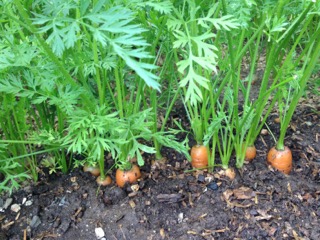byEllyn Myller
Happy fall, the strawberries are still producing! The work of harvesting the late fruits of the field and putting the flower gardens to bed is about to begin, so why am I thinking about spring planting?? Well when the snow has covered the ground and a few months have passed I may not remember what was growing where, what was successful and what I need to consider moving to a new location. “Right plant, right place.”
Tip 1: Record what happened this year. Take some pictures to jog your memory, along with notes; these will come in handy when planning your garden beds and seed ordering time in February.
Garlic was harvested a few weeks back. This new addition to my garden was very successful!! Was it where I planted it, the condition of the soil, can I plant it there again? Time for some research! It’s not recommended to plant garlic in the same location year after year, but it will follow the carrots (light feeders) next year, especially since enriching the soil with compost for the garlic will take place.
Tip 2: Rotate the crops. Root -Fruit -Leaf- Legumes. It’s surprising what specific vegetables are in each of these categories. Next year, beans will replace beets, potatoes/onions into the compost enriched plot that lay fallow this year, the zucchini where the lettuce grew, and the “prize winning” cabbage I hope to grow to this year’s bean “field”.
What about that soil? Tip 3: Time to test the soil. Most Extension Offices have soil testing kits available for pick up. The cost is $35/soil sample, and you mail it in yourself. Putting a dressing of compost on this fall or a cover crop will be done, but testing the soil now will further help to inform what amendments are needed come spring and what will grow best in each of the beds.
I have been so inspired by other gardeners this summer; from those in the Master Gardener class to the Strings Kitchen/Garden Tour, Home Ranch, Elkstone and the Botanical Gardens, fresh ideas abound. Tip 4: Try something new. Start planning now; whether it’s adding complimentary flowering plants to your vegetable garden, a vegetable you’ve never grown, or growing a container of greens in your kitchen this winter - try something new! You could go all out and apply to the CSU Master Gardener Program! We partner to build a strong, knowledgeable and sustainable, happy, gardening community.
Throughout the summer I have been laying in the foundation path and soil for an old-fashioned garden over the lawn in the front yard. Last year and this year too, fall sales on perennials at the nurseries were scooped up and planted in empty beds to be transplanted in this dream garden that I can’t wait to dig into next spring!!
Ellyn Myller and her young family moved to Steamboat Springs from Minnesota in 1996. She is a Class of 2017 Master Gardener. She looks forward to using the many things she's learned in the Master Gardener program to create a more thoughtfully planted, beautiful, and productive garden.




No comments